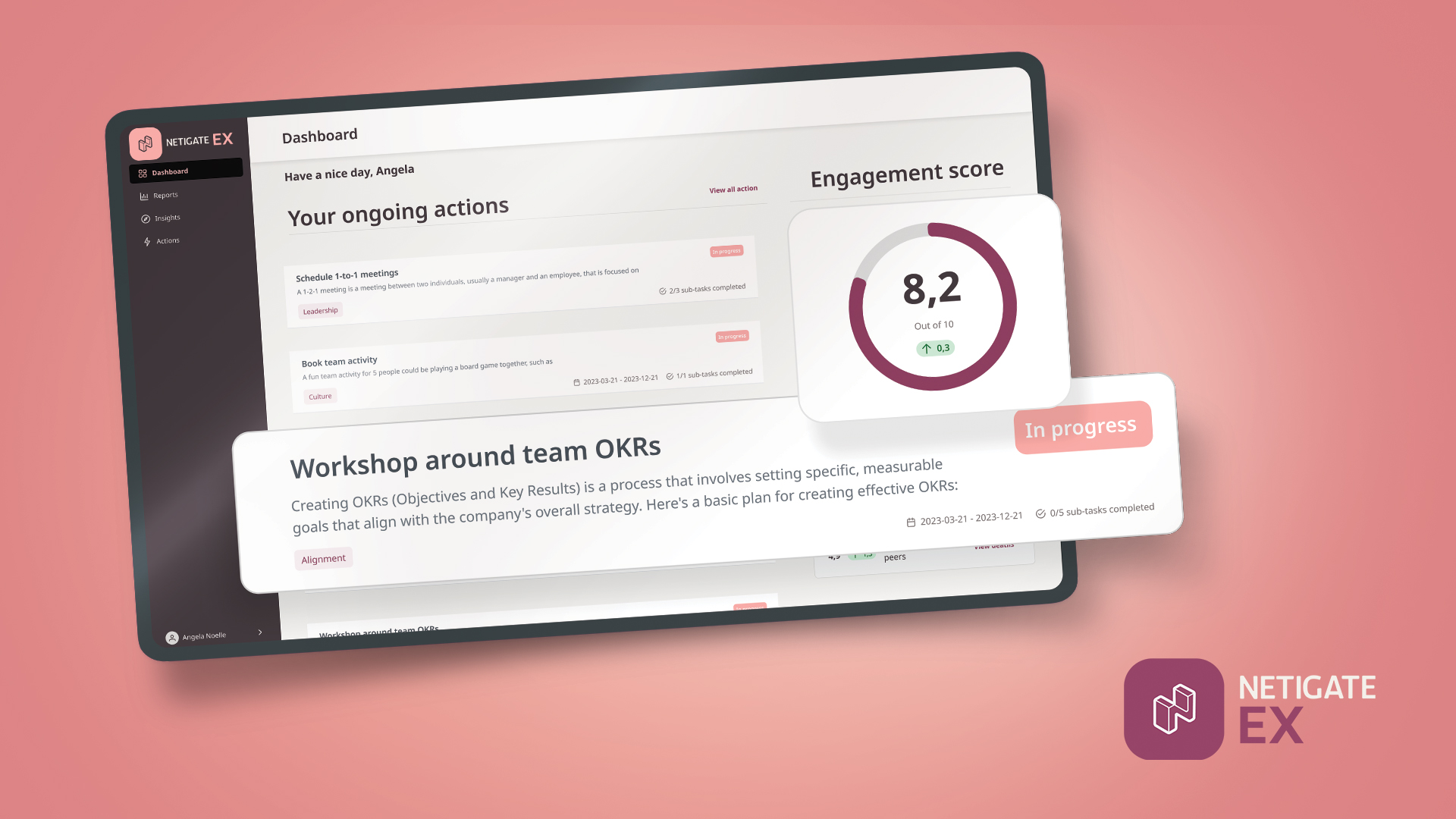Table of Contents
The ultimate guide to improving employee engagement
Employee engagement is a growing focus for companies and HR departments. And for good reason: in times of tight budgets and skills shortages, the personal commitment of individual employees is becoming increasingly important to achieving organizational goals. Not only that, but engaged employees are happier and stay longer.
In this article, you will learn:
- What employee engagement is – and how it differs from “employee satisfaction”
- What the psychological drivers of employee engagement are
- How to measure engagement
- And: What measures of employee engagement really work.
So there’s a lot to talk about – let’s get started!
Table of content:
- What is employee engagement?
- The difference between employee engagement and employee satisfaction
- How do companies benefit from increased employee engagement?
- How do you measure employee engagement?
- What factors influence employee engagement?
- Leadership behaviors and leadership as drivers of employee engagement
- Growth and enablement as drivers of employee engagement
- Relationships as a driver of employee engagement
- Culture as a driver of employee engagement
- Coordination and alignment as drivers of employee engagement
- Meaningful work as a driver of employee engagement
- Recognition and rewards as drivers of employee engagement
- Wellbeing as a driver of employee engagement
- How does an employee engagement survey work?
- What happens after an engagement survey?
- What can the organization do to increase employee engagement?
- Netigate EX Software for Higher Employee Engagement
- Multiple feedback opportunities to increase employee engagement through Netigate
What is employee engagement?
Employee engagement has become a buzzword in human resources. Engaged employees feel a strong connection to their employer, proactively contribute their strengths, take responsibility, and are willing to go the extra mile for the company’s success. Their positive impact on business metrics such as productivity, sales, innovation, and growth has been proven time and time again in the scientific and business communities.
The term was first coined in the early 2000s. However, as University of Toronto researcher Alan Saks writes, there is no truly “robust” definition of the term. Approaches come from two directions:
- One is the burnout field, which focuses on engagement in critical situations.
- On the other hand, from the field of proactive growth cultures, in which the personal commitment of employees is focused on increasing the company’s goals.
Our focus here is on the second aspect: how employee engagement can be used in the company to achieve a better culture, higher employee retention, and, ultimately, better business results.
Employee engagement is created as part of the total employee experience. This means that the ups and downs of engagement are determined at all points in the employee experience.
The difference between employee engagement and employee satisfaction
First, however, we must point out an important difference: Employee engagement is not the same as employee satisfaction they are closely related!
For a long time, employee surveys focused on employee satisfaction. This approach was based on the assumption that satisfied employees would automatically perform better and that increasing employee satisfaction would also drive business success. In fact, scientific research provides only limited support for this assumption.
While a certain level of job satisfaction is necessary, it is by no means a sufficient condition for high engagement, as the data from this year’s Netigate Engagement Benchmark Study also shows.
For example, many companies measure employee satisfaction using eNPS scores. This is a very robust indicator, but it does not yet reflect engagement levels.
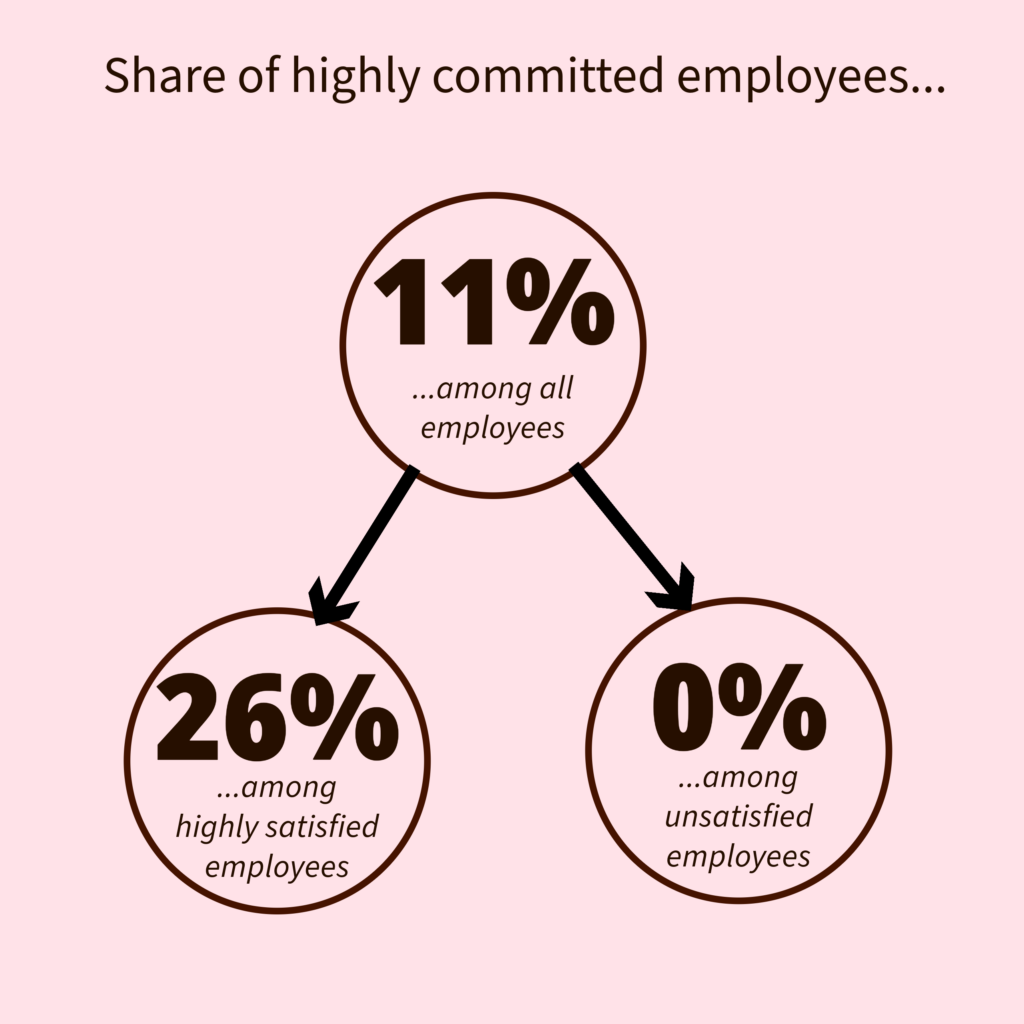
Employee satisfaction and employee engagement are related – but they’re not the same thing, as these figures from the Netigate Employee Engagement Benchmark Study show.
How do companies benefit from increased employee engagement?
One thing is clear: companies with satisfied and engaged employees are more successful than their competitors. This correlation is obvious – and increasingly supported by scientific studies.
For example, Gallup recently concluded that good engagement leads to 23% higher profitability and 18% higher productivity.
But the secondary factors, such as increased employee loyalty, stronger commitment to customer concerns, and ultimately more “happiness at work,” are also critical for organizations in an increasingly demanding labor market.
So, with so many good reasons to work on increasing employee engagement, let’s get started! And as is often the case, the first step is to measure employee engagement.
How do you measure employee engagement?
How would you answer the question, “How engaged are you today? As you can see from this question alone, measuring engagement is not easy. In fact, even if you were to define your “level of engagement” today on a scale of 0 to 10, you would have to see: Your current assessment of engagement depends on many factors.
So is the measurability of employee engagement as a whole.
However, the good news is that employee engagement is measurable – if you go about it the right way.
According to standard psychological driver models, the level of employee engagement is the interaction of various factors in the employee experience, or drivers. These can include the relationship with the leader, the leadership culture, the interaction within the team, or the meaningfulness of individual tasks.
For each of these drivers, a large number of specific questions can be asked and answered quickly and truthfully. And the interaction of these drivers with each other then results in an overall value for employee engagement.
This is exactly the principle behind Netigate EX Engage, the all-new software for measuring and increasing employee engagement, which we describe in detail below.
So, to measure employee engagement, keep these 3 core principles in mind:
- Employee engagement is made up of different factors, the drivers.
- The interaction of these drivers results in a measure of employee engagement as a whole.
For executives and HR managers, however, it is also important to look at each of these drivers individually – because statements about leadership behavior or culture, team culture, and well-being, for example, are important for initiating individual and targeted improvement measures.
In addition to measuring engagement, it is always a good idea to measure the Employee Net Promoter Score (eNPS) as a benchmarking indicator of employee engagement.
What factors influence employee engagement?
As mentioned above, there are several factors that influence employee engagement, the so-called drivers. As a feedback software provider in the market since 2005, we at Netigate have long been concerned with the motivating factors for greater engagement – and therefore, based on scientific research, we have developed our driver model, which starts at crucial points in the employee experience.
It is based on the following drivers:
Leadership behaviors and leadership as drivers of employee engagement

Managers and team leaders have a significant impact on employee engagement. They set the tone for the work environment and shape the relationships between managers at all levels and their teams.
Leaders can foster engagement and motivation by creating a supportive and inspiring culture, communicating effectively, setting clear expectations, and recognizing and valuing employee contributions.
Growth and enablement as drivers of employee engagement

Growth and development is a critical part of the employee experience that drives engagement in the workplace. When employees have the opportunity to learn new skills, expand their knowledge, and advance their careers, they feel they have grown personally and professionally. This not only builds their confidence and competence but also shows that the company values their potential and is investing in their future.
When employees feel supported in their development, they are more motivated and committed to their work. They contribute actively and bring new ideas, innovation, and a sense of ownership to their roles. As a result, Growth and Enablement create a culture of continuous improvement and enable people to reach their full potential, resulting in higher engagement, greater job satisfaction, and greater business success.
Relationships as a driver of employee engagement

The relationships we have at work play a critical role in our engagement. Beyond the daily tasks and deadlines, it is the relationships we have with our team members and managers that give us a sense of belonging and purpose at work. Research on self-determination theory shows that motivation at work is strongly influenced by our sense of connection to others.
Culture as a driver of employee engagement

Corporate culture is a living network of values, beliefs, behaviors, and norms that shape the environment in which employees thrive. It is the personality of an organization. It influences how people interact, collaborate, and find meaning in their work.
A strong and positive culture fosters a sense of belonging, trust, and commitment. It enables people to perform at their best and creates an atmosphere where everyone feels valued and motivated. This sets the stage for a dynamic and engaging work environment that increases productivity, employee satisfaction, and engagement, and positively impacts the employee experience.
Coordination and alignment as drivers of employee engagement

“Workplace alignment” plays a critical role in employee engagement, resulting in a more motivated, engaged and productive workforce. When employees feel aligned with the company’s goals, values, and vision, they develop a sense of purpose and connection to their work.
Meaningful work as a driver of employee engagement

“Meaningful work” refers to the sense of purpose, fulfillment, and meaning we experience in our work. It’s not just about completing tasks and making money. It’s about a deep connection between your values and passions what you do and what you make happen.
It’s about feeling like you’re contributing, making a difference, and finding personal satisfaction in the work itself. What constitutes meaningful work can vary from person to person. It is often tied to individual values, interests, and goals.
Recognition and rewards as drivers of employee engagement

Research from Gallup and Workhuman shows that employees who feel “fulfilled” by recognition are four times more likely to be engaged than their peers who do not. In fact, employees who do not feel recognized at work are eight times more likely to be disengaged.
This underscores the importance of recognizing and rewarding employees for their accomplishments. In addition, research on self-determination theory shows that our motivation to work is strongly influenced by our sense of relatedness to others.
Wellbeing as a driver of employee engagement

Employee engagement thrives when people feel supported, empowered, and balanced. By investing in employee wellness initiatives, organizations not only demonstrate their commitment to the physical and mental well-being of their employees but also create an environment where each individual can thrive and perform at their best.
From promoting a positive work-life balance to supporting stress management and overall health, wellness initiatives provide the energy, enthusiasm, and productivity that drive employee engagement.
How does an employee engagement survey work?
Good employee engagement surveys build on the above drivers (or specific sub-questions about their sub-drivers) around the employee experience.
For example, the “leadership” driver builds on the three sub-drivers of communication with, feedback from, and trust in the direct supervisor or team leader. Satisfaction (and ultimately engagement) can then be reliably broken down by sub-driver using specific, clearly answerable questions. For example, these might be (each on a scale of 1 to 5)
- My direct manager gives me the support I need to do my job.
- My direct manager is good at motivating me
- My direct manager creates opportunities for open discussion within our team
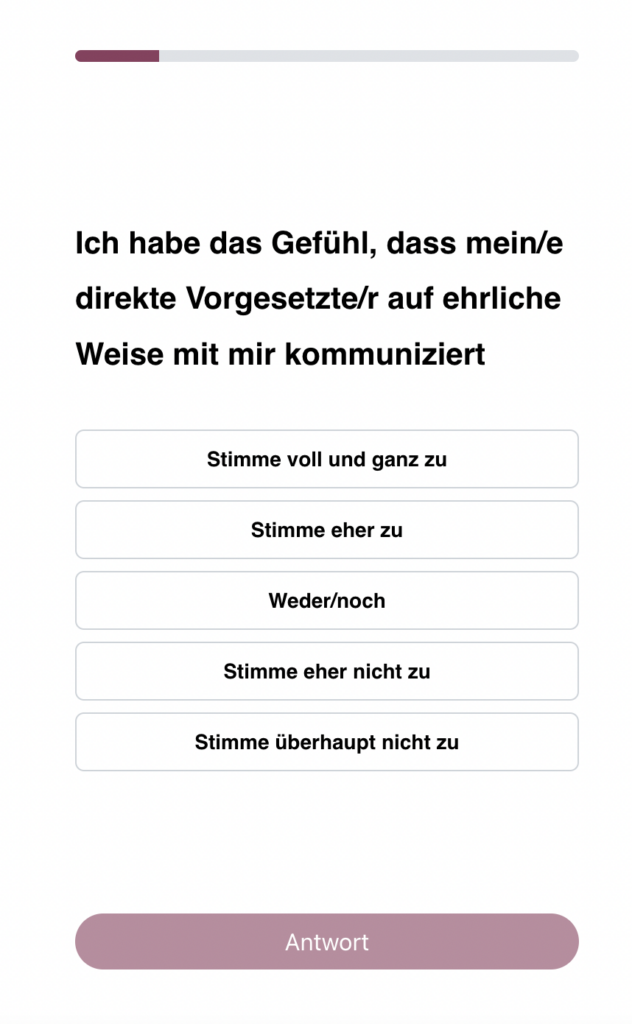
A sample question from the Netigate EX Engage employee engagement software.
Overall, this results in an extensive catalog of questions on the various aspects of engagement drivers. Ideally, these are not asked in a single, large survey, but in regular, shorter “pulse” surveys. Over time, this results in a robust and meaningful database that can be continually updated with new results.
Since employee surveys can touch on sensitive data, the anonymity of the results is important. Our Netigate EX Engage software is programmed in such a way that the results cannot be traced back to any individual.
What happens after an engagement survey?
As different as the drivers of engagement are, so are the measures to address them. But one thing is certain: companies, managers and HR departments have a wide range of tools at their disposal to increase individual and team engagement.
These can include workshops with the team to improve team culture. Eating dinner with the team. Creating a running group. Developing a professional development plan.
Ultimately, the specific actions will result from the individual engagement situation of the team and the employee. In the case of the Netigate EX Engage software, it is therefore also a learning AI that identifies and suggests exactly the right actions; users also have the option of adding their own actions to the checklists in the tool.
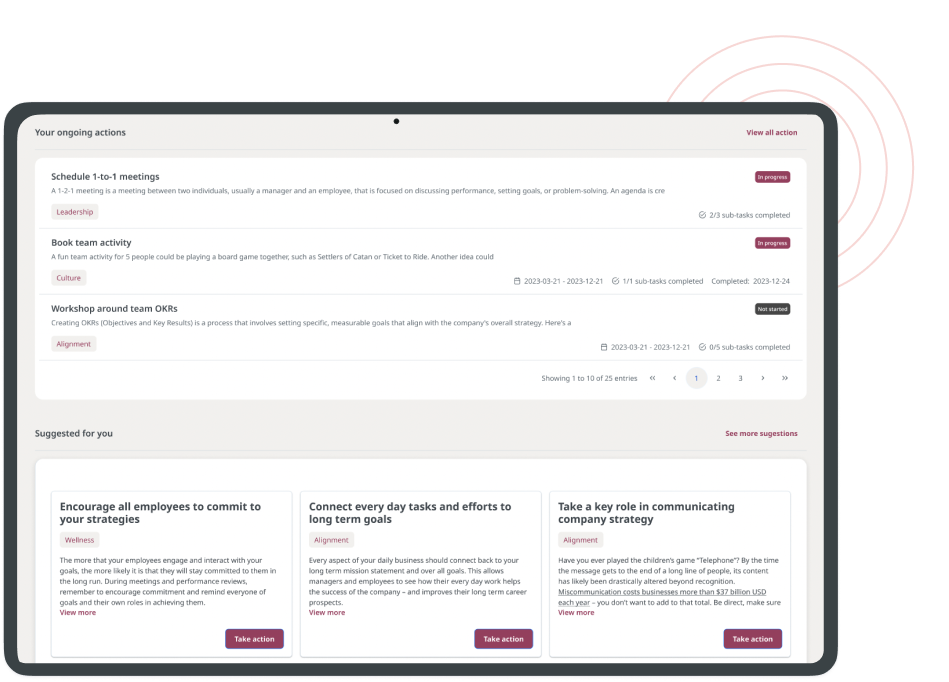
Generally, at Netigate, we recommend that our clients openly and transparently communicate and discuss the results of engagement reports based on pulse surveys with their team – to get a shared sentiment as well as further ideas and “buy-in” to improve the culture.
What can the organization do to increase employee engagement?
In addition to the individual measures mentioned, the most important task at the corporate level is to create a positive culture for growing employee engagement.
This includes regular communication from the top, especially an open, non-hierarchical culture of communication and leadership.
Creating a positive culture of engagement is undoubtedly a change for many organizations that cannot be achieved overnight. A long-term transformation strategy that is openly communicated to employees is also important.
In this context, it is also advisable to view increasing employee engagement as a process and to measure engagement on an ongoing basis. In this way, the impact of initiated measures can be efficiently measured and evaluated over time. The use of short, regular pulse surveys is also recommended for this purpose, as is the regular recording and reporting of eNPS.
Netigate EX Software for Higher Employee Engagement
With Netigate EX Engage, Netigate has developed a ready-to-use AI tool for increasing employee engagement – giving team leaders and HR teams a tool that is as smart as it is practical for their daily work.
Based on a sophisticated psychological driver model, the tool regularly sends pre-designed, short, and verified pulse surveys to employees via secure email connections. The results of these surveys are included in the tool’s engagement reports, which are available to managers for further work.
With sufficient data, AI-supported individual recommendations for action are also developed, which can be managed in a kind of checklist together with the user’s own entries.
In addition to pulse surveys, Netigate EX Engage also offers a free eNPS measurement module.
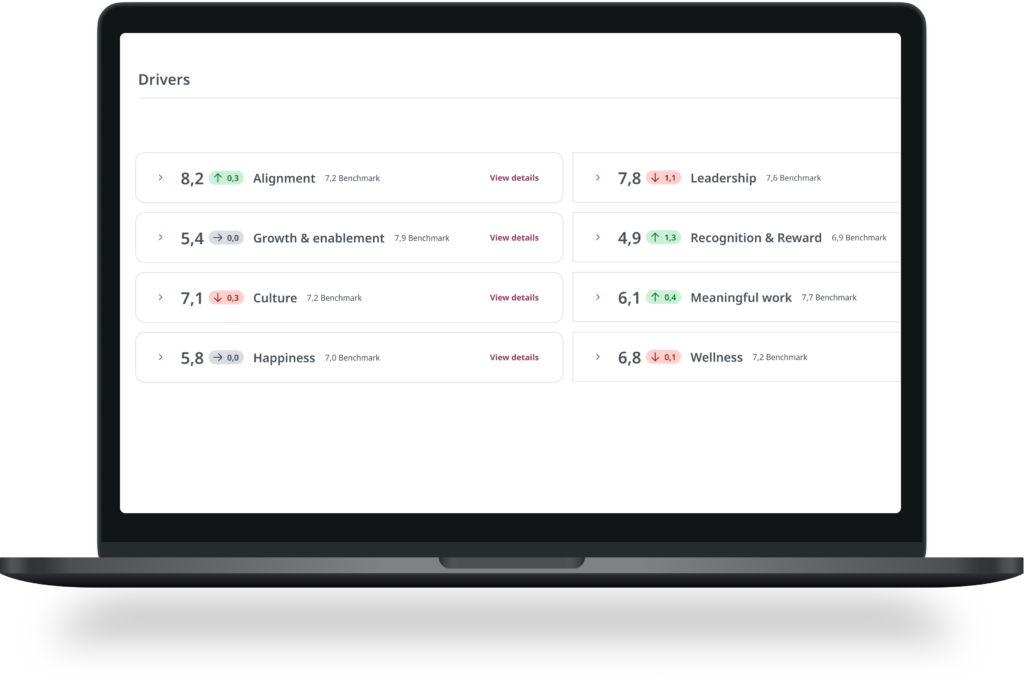
Multiple feedback opportunities to increase employee engagement through Netigate
In addition to the employee engagement tool, Netigate also offers the comprehensive survey tool “Netigate Feedback” for all types of employee surveys (e.g. eNPS, employee satisfaction, exit surveys, 360-degree feedback, etc.). Many customers also take advantage of the Netigate Consulting Team’s offer to support them in partial or complete projects related to employee feedback.
-
Helena Bjorkman
-
Helena Bjorkman
- 10 min read
- .


